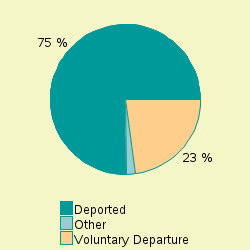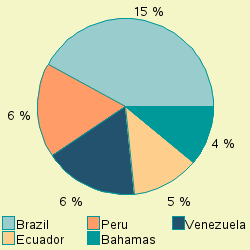Detainees Leaving ICE Detention from the
Krome/Miami Hub
Miami, Florida
Detainees Deported or Released Number last 12 months 614 Out of total detained 672 Facility ranking on detainees top 22 %
Table 1: Number leaving ICE detention
from this facilityDuring the most recent 12 month period for which data are available, a total of 614 detainees housed at the Krome/Miami Hub left that facility because they were deported, were released under supervision while their cases were being decided, or left ICE detention for one of a variety of other reasons. This facility is an ICE Service Processing Center (SPC). While this SPC is an ICE facility, now all SPCs are currently operated by private contractors.
Those individuals who departed from this facility because they were leaving ICE detention made up 91 percent of the 672 detainees housed at this facility during the last 12 months. This report focuses on the reasons these individuals left ICE detention. Sometimes this report speaks of these individuals as those "exiting" ICE detention, or simply as "exits." The others remained in ICE detention but were transferred from the Krome/Miami Hub to other facilities.
This report covers those who left ICE custody. It excludes individuals transferred to other ICE facilities. For more information on this facility, including individuals that were transferred, see additional TRAC reports in this series.
This report series is based upon analyses conducted by the Transactional Records Access Clearinghouse (TRAC) at Syracuse University of 1.7 million government records tracking each individual who passed through an ICE detention facility during fiscal year 2015. This most recent 12 month period for which comprehensive data are available covers October 2014 through September 2015. See About the Data.
How This Facility Ranks Nationally
Rankings on the number leaving ICE detention. The Krome/Miami Hub was one of 637 facilities nationwide that housed ICE detainees during the most recent 12 month period. Of these 637, there were 358 that had at least 10 individuals who were deported or released. Excluding those facilities with fewer than 10 exits, the Krome/Miami Hub last year ranked in the top 22 percent nationwide in the number of individuals leaving ICE detention. This means that 22 percent of the locations contributed the same or a larger numbers of exits, while 78 percent had a smaller number. See Table 1.
Deportations. Nationally, the most common reason that a detainee left ICE detention was that they were deported from the United States. During the most recent 12 month period for which comprehensive data are available, nationwide 56.3 percent of those leaving ICE detention were deported or "voluntarily" departed. By way of comparison, a higher percentage of detainees (98 percent) left the country from the Krome/Miami Hub because they were formally deported, or left under the so-called "voluntary departure" procedure.
Were Detained Individuals from the Local Area?
Information on the place of arrest was not included in the available data ICE released. However, we can examine whether the Krome/Miami Hub was the first ICE facility in which these detainees were held. According to ICE records, for a few (3) of these detainees, the Krome/Miami Hub was the first place they were sent when they were detained by ICE. Virtually all had been transferred in from another ICE detention facility.
We can also look at how quickly they arrived at this facility after they were first detained. A total of 1 percent arrived at the Krome/Miami Hub at some point during the very first day they were detained by ICE. There was considerable variability among detainees in the number of detention facilities they had been held in before they were finally deported or released from this facility. The number of facilities ranged as high as 7 separate locations for some detainees. These figures again are based on an analysis of the most recent 12 months for which data are available.
For the United States as a whole, last year the average number of ICE facilities detainees moved through was 1.8. Detainees at the Krome/Miami Hub on average had stayed at somewhat more (2.9) ICE facilities.
Reason Left ICE Facility Profile U.S Profile Number Percent Percent Deported/Removed 462 75.2 % 55.3 % Voluntary departure 141 22.9 % 0.9 % Withdrawal 6 0.9 % 0.2 % Alternative ATD custody 3 0.4 % 0.1 % Orders of Recognizance or Supervision 2 0.3 % 19.8 % Bonded out 0 . 11.0 % Died 0 . 0.0 % Escaped 0 . 0.0 % Release to ORR 0 . 0.1 % Paroled 0 . 5.2 % Prosecutorial Discretion 0 . 1.0 % Proceedings Terminated 0 . 1.3 % U.S. Marshal or Other Agency 0 . 4.5 % Total 614 100.0 % 100.0 %
Table 3: Reasons individuals left ICE detention during the last 12 months
Why Did Detainees Leave ICE Detention?
ICE records one of 29 reasons a detainee left ICE detention. As shown in Table 3, these reasons fall into 13 general categories -- from leaving because one is deported or removed, to leaving because one escaped or the individual died while in custody.
Deportation. As mentioned earlier, the most common reason detainees left the Krome/Miami Hub was that they were deported. A total of 462 individuals (75 percent) were deported or removed from the Krome/Miami Hub during the most recent 12 month period for which data are available. (ICE data did not distinguish between deportations and removals, and the terms are used interchangeably in this report.)
Voluntary departure. Under some circumstances, detainees are allowed to take "voluntary departures" or "voluntary returns." As with deportation, under voluntary departure a person must leave the country. However, unlike formal deportation where the individual is barred by law from reentering this country permanently or for a period of years, under voluntary departure and voluntary return the individual is not legally barred from reentry. An additional 141 detainees (23 percent) left the Krome/Miami Hub last year as voluntary departures and voluntary returns.
Withdraw entry request. Individuals also leave ICE detention for a variety of additional reasons. One of these is that individuals who have been detained may be allowed to "withdraw" their request to enter the country. If a person withdraws their request, this effectively means they must leave the country. A total of 6 individuals (1 percent) fell into this category. Unlike deportation where the person is legally barred for a period of years and sometimes permanently from coming back to the United States, a person who withdraws their request is not for that reason barred from re-entry into this country.
Escape and death. Nationally, there were 65 individuals who escaped ICE detention during the latest 12 month period for which data are available, and 6 individuals were recorded as having died in detention. No one was recorded by the Krome/Miami Hub as either escaping or dying last year.
As shown in Table 3, no one was recorded as leaving the Krome/Miami Hub during the past 12 months for the following reasons: Bonded Out, Release to ORR, Paroled, Prosecutorial Discretion, Proceedings Terminated and U.S. Marshals or other agency. See "Reasons for Leaving ICE Detention" for a description of these categories.
Comparing Release Reasons Against The National Picture
In many respects release reasons for the Krome/Miami Hub departed from the national picture. It was the case that a higher proportion left because they were deported from this facility (75 percent) than was true for the U.S. as a whole (55 percent). A higher proportion (23 percent) left this facility as voluntary departures than was true nationally (1 percent).
In addition, differences were seen for detainees released on orders of recognizance or supervision (0 versus 20 percent), individuals released on bond (none versus 11 percent), for those paroled (none versus 5 percent), and those released to the U.S. Marshal or other agency (none versus 5 percent).
The facility's percentages fell within 3 percentage points of the national figures for all other categories.
Nationalities
Which nationalities predominate? Last year in the United States, individuals from Mexico comprised the largest number of those leaving ICE detention. Some 43.4 percent of all detainees recorded Mexico as their country of origin. The Krome/Miami Hub had a much smaller proportion of detainees from Mexico - 2 percent among their exits. Detainees from Mexico were not the largest single nationality group among those leaving detention from the facility.
In descending order, the top nationalities that made up those leaving ICE detention from the Krome/Miami Hub last year were: Brazil (15%) , Peru (6%), Venezuela (6%), Ecuador (5%) and Bahamas (4%).
This compared to the United States as a whole where the other top five nationalities after Mexico were Guatemala (19%), El Salvador (15%), Honduras (12%) and Ecuador (1%).
For the frequency for each of the other nationalities within the top 10 among those leaving ICE detention from the Krome/Miami Hub last year see Table 4.
Deportations and voluntary departures by nationality. Within the nationalities that made up those listed in Table 4 with more than one individual, the proportion deported or voluntarily departing varied from 93 percent to 100 percent. As mentioned above, this compares with 98 percent for all detainees.
Nationalities Ranked in Top 10 Left ICE Detention Total Deported/
Voluntary
DeparturePercent - ALL 614 603 98.2 % 1 Brazil 95 94 98.9 % 2 Peru 39 39 100.0 % Venezuela 39 38 97.4 % 4 Ecuador 28 26 92.8 % 5 Bahamas 25 25 100.0 % 6 Haiti 23 23 100.0 % 7 El Salvador 22 22 100.0 % 8 Argentina 20 20 100.0 % 9 Colombia 17 16 94.1 % 10 Canada 15 15 100.0 % India 15 15 100.0 % Mexico 15 14 93.3 %
Table 4: Numbers leaving ICE detention by nationality
during the last 12 months
More than one country was tied with the highest rate of 100 percent, where detainees were deported or took voluntary departure. More than one country was tied with the lowest rate of 93 percent, where detainees were deported or took voluntary departure.


